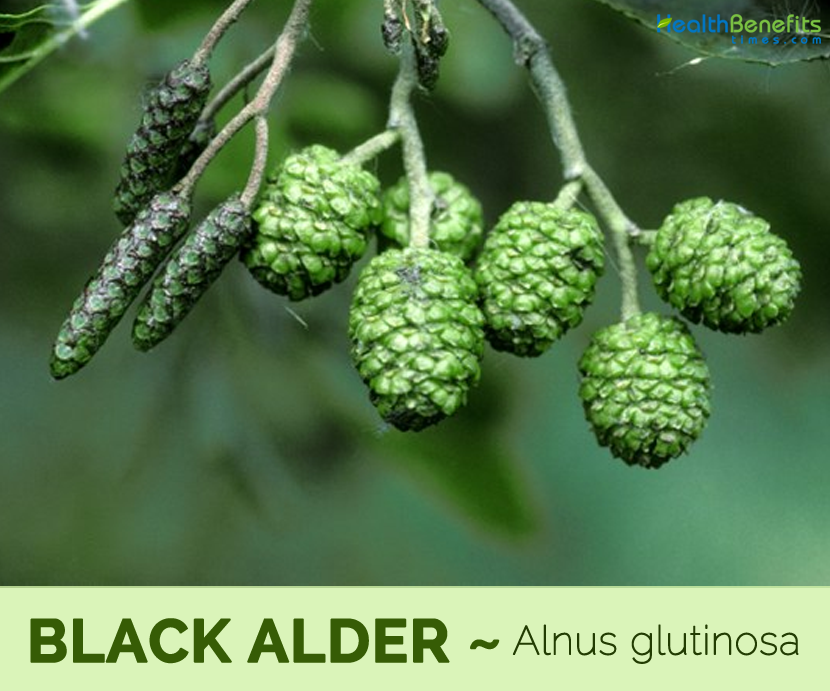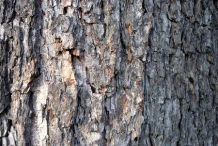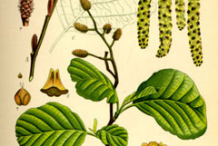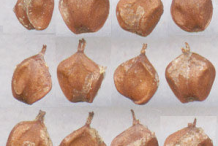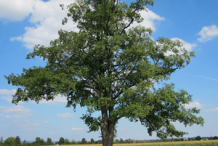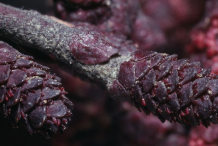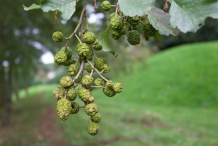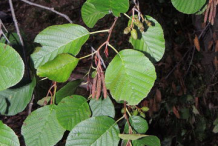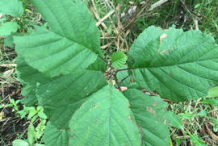| Black Alder (European alder) Quick Facts |
| Name: |
Black Alder (European alder) |
| Scientific Name: |
Alnus glutinosa |
| Origin |
Europe and western Asia, North Africa and Asia Minor |
| Colors |
Green becoming dark brown or black |
| Shapes |
Small, winged seeds grouped in cone-like green strobiles |
| Health benefits |
Maintain oral health and Prevention against cancer |
Black alder (Alnus glutinosa), commonly known as alder, Common Alder, European alder, European black alder is a small to medium-sized deciduous tree that is distinguished by its gummy young twigs and leaves and its obovate to rounded, glossy dark green leaves. It is a member of the Birch (Betulaceae) family and is closely related to other alders (Alnus), as well as to birches (Betula), hazels (Corylus), Blue Beech (Carpinus caroliniana) and Hophornbeam (Ostrya virginiana). The tree is native to Europe, western Asia, North Africa and Asia Minor mostly along streams and in low or swampy sites. Black Alders are easily recognized in winter by the presence of the drooping male catkins and the woody cones, both of which are ornamentally attractive. Winter branches are often added to floral arrangements. Dark brown bark with warty striping gives rise to the black alder common name.
Plant Description
Black Alder (European alder) is a moderately-sized deciduous tree or large shrub which is found growing about up to 30 meters (100 ft.) tall and 30 cm diameter. The tree is found growing in wetlands, riparian zones, lakesides, natural forests, planted forests and ruderal/disturbed areas. Bark is normally smooth and greenish brown when it is young. As the tree matures it turns greyish brown with short warty, horizontal stripes (called lenticels) and shallow cracks. Twigs are sticky when young, and produce stalked buds that are purplish in color. Similarly branches are smooth and somewhat sticky, being scattered with resinous warts.
Leaves
Leaves are simple, alternate and leathery. They have serrated margin and a rounded shape with either a blunt tip or indented tip. Young leaves feel sticky when touched but become smoother with age. The leaves are usually up to 13 cm long, and 5-8 cm wide with raised veins on the underside. They have a glossy dark green upper surface and paler green underside with rusty-brown hairs in the angles of the veins. The leaves are rich in nitrogen and add additional nitrogen to the soil as they decompose. Young leaves are sticky to the touch.
Flowers/Fruit
European Black Alder is monoecious tree bearing both male and female flowers on the same tree. The thin, reddish brown drooping male flowers (catkins) develop in the fall, overwinter on the tree and expand in spring before the leaves emerge. In the spring, female flowers (also referred to as catkins) emerge and are fertilized by pollen from male catkins. After they are fertilized, the female catkins harden into cone-like fruit which produce small winged seeds.
The female ‘cones’ grow in clusters near the branch tips and these remain green until the seeds are released. They begin to turn brown. European Black Alder can flower in its second growing season. They produce an average of 60 seeds per cone and up to 4,000 cones per tree on mature trees. Seeds contain an air bladder which helps them to float in water. European Black Alder mostly spreads via seeds. They usually germinate within the first year.
Health benefits of Black Alder (European alder)
Black alder is a plant. The bark is used to make medicine. People take black alder for intestinal bleeding and sore throat. It is sometimes used as a gargle for sore throat, especially strep throat. Listed below are few of the health benefits of black elder
1. Help maintain oral health
Alder is known to possess astringent properties and is therefore known to be beneficial in treatment of numerous oral issues such as cavities and foul smell.
2. Help stop bleeding
This herb has been known to be effective in treating external as well as internal bleeding. It is known to be one of the effective cures of scabies an infection caused by itch mite.
3. Helps treat inflammation
Decoction prepared from this herb is known to be helpful in treatment of numerous inflammation issues. It is known to treat shivering or shaking if caused and can effectively eliminate rheumatism.
4. Prevention agent against cancer
Decoction prepared from this herb has been known to effectively treat issues such as cancer particularly those occurring in face, tongue and breast.
Other Traditional uses and benefits of Black Alder (European alder)
- Decoction of the bark is useful to bathe swellings and inflammations, especially of the throat, and has been known to cure ague.
- Peasants on the Alps are reported to be frequently cured of rheumatism by being covered with bags full of the heated leaves.
- Powdered bark and the leaves have been used as an internal astringent and tonic.
- Bark has also been used as an internal and external haemostatic against hemorrhage.
- Boiling the inner bark in vinegar produces a useful wash to treat lice and a range of skin problems such as scabies and scabs.
- Liquid can also be used as a tooth wash.
- Leaves are astringent, galactogogue and vermifuge.
- They are used to help reduce breast engorgement in nursing mothers.
- Decoction of the leaves is used in folk remedies for treating cancer of the breast, duodenum, oesophagus, face, pylorus, pancreas, rectum, throat, tongue, and uterus.
- Decoction prepared with the bark of the alder may also be used to stop internal as well as external bleeding and also to cure injuries.
- Medication prepared with the leaves of the alder is also an effective wash for scabies.
- People in Spain curve the leaves of the alder and put them on the soles of aching feet.
- Decoction prepared with the bark of the alder is an effective medication to wash swelling and inflammations, particularly of the throat.
- Decoction of the bark has been used to treat swelling, inflammation and rheumatism, as an emetic, and to treat pharyngitis and sore throat.
- Alpine farmers are said to use the leaves to alleviate rheumatism by placing a heated bag full of leaves on the affected areas.
Other Facts
- Bark is used by dyers, tanners, leather dressers, and for fishermen’s nets.
- Leaves have been used in tanning leather.
- Powdered bark has been used as an ingredient of toothpastes.
- Sticks of the bark have been chewed as tooth cleaners.
- An ink and a tawny-red dye are obtained from the bark.
- Green dye is obtained from the catkins.
- Pinkish-fawn dye is obtained from the fresh green wood.
- Yellow dye is obtained from the bark and young shoots.
- Cinnamon dye is obtained from the shoots.
- Leaves are clammy and, if spread in a room, are said to catch fleas and flies on their glutinous surface.
- Wood is used for furniture, pencils, bowls, woodcuts, clogs etc. It is much valued by cabinet makers.
- Wood is also makes a good charcoal.
- It is often used as firewood, as a papermaking and particle board fiber and in joinery.
- Alder wood is traditionally used to produce smoked meats and fish.
- According to some people, consumption of alder leaves causes blackening of the tongue and is harmful to horses.
Formulas or Dosages
- Infusion: Use 1 heaping tbsp. crushed alder leaves to 1 pint boiling water. Let steep for 1/2 hour.
- Decoction: Boil 1 tsp. bark, or leaves in 1 cup water. For internal use, take 1-2 cups a day, in mouthful doses.
- Tincture: A dose is from 1/2 to 1 tsp.
- Powder: A dose is from 8-12 grains.
- Poultice: Use just enough water to moisten the leaves.
Uses
Timber
Wood is soft, white when first cut, turning to pale red; the knots are attractively mottled. The timber is not used where strength is required in the construction industry, but is used for paper-making, the manufacture of fiber board and the production of energy. Under water the wood is very durable and is used for deep foundations of buildings. The piles beneath the Rialto in Venice, and the foundations of several medieval cathedrals are made of alder. The Roman architect Vitruvius mentioned that the timber was used in the construction of the causeways across the Ravenna marshes. The wood is used in joinery, both as solid timber and as veneer, where its grain and color are appreciated, and it takes dye well. As the wood is soft, flexible and somewhat light, it can be easily worked as well as split. It is valued in turnery and carving, in making furniture, window frames, clogs, toys, blocks, pencils and bowls.
Tanning and dyeing
Bark of the common alder has long been used in tanning and dyeing. The bark and twigs contain 16 to 20% tannic acid but their usefulness in tanning is limited by the strong accompanying color they produce. Depending on the mordant and the methods used, various shades of brown, fawn, and yellowish-orange hues can be imparted to wool, cotton and silk. Alder bark can also use with iron sulphate to create a black dye which can substitute for the use of sumach or galls. The Laplanders are said to chew the bark and use their saliva to dye leather. The shoots of the common alder produce a yellowish or cinnamon-colored dye if cut early in the year. Other parts of the tree are also used in dyeing; the catkins can yield a green color and the fresh-cut wood a pinkish-fawn color.
Other uses
It is also the traditional wood that is burnt to produce smoked fish and other smoked foods, though in some areas other woods are now more often used. It supplies high quality charcoal.
Leaves of this tree are sticky and if they are spread on the floor of a room, their adhesive surface is said to trap fleas.
Precautions
- Fresh bark may cause nausea and vomiting.
- It should be avoided by pregnant and breast feeding.
References:
https://plants.usda.gov/core/profile?symbol=algl2
http://www.theplantlist.org/tpl/record/kew-6376
https://www.itis.gov/servlet/SingleRpt/SingleRpt?search_topic=TSN&search_value=19470#null
http://davesgarden.com/guides/pf/go/50040/
https://npgsweb.ars-grin.gov/gringlobal/taxonomydetail.aspx?id=2448
http://www.missouribotanicalgarden.org/PlantFinder/PlantFinderDetails.aspx?kempercode=a929
http://www.floracatalana.net/alnus-glutinosa-l-gaertn
https://www.nature.nps.gov/water/marineinvasives/assets/PDFs/GreatLakes/Alnus_glutinosa.pdf
http://www.botanical.com/botanical/mgmh/a/alder019.html
http://www.pfaf.org/user/Plant.aspx?LatinName=Alnus+glutinosa
http://www.ontarioinvasiveplants.ca/wp-content/uploads/2016/06/OIPC_BMP_EuropeanBlackAlder.pdf
http://www.docs.dcnr.pa.gov/cs/groups/public/documents/document/dcnr_010276.pdf
https://plants.usda.gov/factsheet/pdf/fs_algl2.pdf
https://en.wikipedia.org/wiki/Alnus_glutinosa
https://www.na.fs.fed.us/fhp/invasive_plants/weeds/european-alder.pdf
https://nas.er.usgs.gov/queries/GreatLakes/FactSheet.aspx?SpeciesID=2696
http://www.misin.msu.edu/facts/detail/print.php?id=1
http://www.cabi.org/isc/datasheet/4574
https://nas.er.usgs.gov/queries/GreatLakes/FactSheet.aspx?NoCache=9%2F13%2F2013+7%3A22%3A14+AM&SpeciesID=2696&State=&HUCNumber=
http://hort.ifas.ufl.edu/trees/ALNGLUA.pdf
Comments
comments


